Talent Management Whitepapers
HR and talent management practitioners are faced today with daunting challenges. Workforces are changing fast – hierarchies are flatter, career paths are no longer linear, workers are more geographically dispersed, and generational differences are as sharp as ever. Ensuring that you have the right people with the right skills in the right roles and at the right time has a serious impact on your organization's ability to execute and grow.

An Opportunity for Change 10 Recommendations for Advancing Your HR Technology Strategy
Today's uncertain economic environment is forcing many companies into drastic measures, including major workforce reductions, business closures, and elimination of other corporate resources. Yet business leaders are still being called upon to deliver more with less. As a result, they are turning to HR for guidance on how to effectively retain and deploy their talent in alignment with organizational goals.
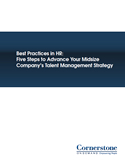
Best Practices in HR: Five Steps to Advance Your Midsize Company's Talent Management Strategy
Savvy leaders realize the importance of developing their internal bench strength today to competitively address the organizational demands of tomorrow. In reality, identifying and adopting the ideal components needed to support an integrated performance and learning management process is complex and time-consuming. For midsize organizations with limited resources, it's even more challenging.

Compliance Challenges for Today's Talent Managers
Today, companies in a wide range of industries must expend extraordinary amounts of time and capital to conform to a host of regulatory requirements. Applicable regulations may include requirements of the Financial Industry Regulatory Authority (FINRA, previously called the National Association of Securities Dealers [NASD]), the Sarbanes-Oxley Act (SOX), the Health Insurance Portability and Accountability Act (HIPAA), U.S. Food and Drug Administration (FDA), The Joint Commission's HR standards (formerly known as JCAHO), Basel II, and many others.
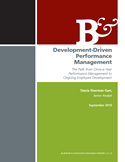
Development-Driven Performance Management The Path from Once-a-Year Performance Management to Ongoing Employee Development
This document is part of the Bersin and Associates Research Library. Our research is provided exclusively to organizational members of the Bersin & Associates Research Program. Member organizations have access to the largest library of learning and talent management related research available.
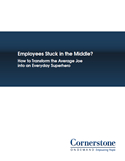
Employees Stuck in the Middle? How to Transform the Average Joe into an Everyday Superhero
The terms "high performer" and "low performer" are firmly entrenched in the lexicon of talent management – and for good reason. High performers are your company's superheroes and the low performers are a constant management challenge. But what about employees that fall in "the middle"? What about the Average Joes?
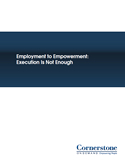
Employment to Empowerment: Execution Is Not Enough
In the 21st century, the nature of work has fundamentally changed. The drivers of this change are obvious to most of us. The explosion of online, social and mobile technologies, coupled with the expansion of global business, has resulted in a 24/7 worldwide workplace. In many jobs and in many industries, we can work anywhere, at any time. It's a new world.

Failing to Learn: Why Learning is Critical to Strategic Talent Management
Many organizations, regardless of size or industry, are turning to talent management technology solutions to achieve a significant business impact. According to Bersin & Associates research, companies with intermediate to advanced levels of talent management performed better financially during the recession as well as generated higher revenue per employee and lower overall voluntary turnover.

How Kelly Services Implemented Onboarding To Retain Quality Workers
Kelly Services did not have a formal onboarding program. New hires spent a few hours hearing about the company, its policies and procedures, and then learned on the job — some succeeded, others didn't. Even with good recruiting, succession planning, and learning opportunities, the retention rates and the ramp-up rates were not acceptable. The learning department was tasked with reversing this trend. With the introduction of a formal onboarding program, the employee retention rate increased, and employees were happier and more productive.

Integrated Learning and Performance
In today's "Age of Talent", Enterprise Learning and Talent Management have become key factors in organizations' strategic competitiveness. The tight labor market, coupled with an increased focus on driving performance through a more engaged and skilled workforce, will be a catalyst for further alignment between training, performance management and overall Talent Management.

Making the Best of It: Why Tough Times Make Talent Management Essential in the Public Sector
Today's fiscal realities are leaving few good choices for federal, state and municipal entities. Budgets have never been tighter, spending cuts are inevitable and many reductions will come in the areas of personnel and training. However, public sector employers need to consider the talent impacts of these cuts in light of generational shifts, impending retirements and the need to fill leadership and talent gaps.

Managing Talent in a Nonprofit Environment
United Way of the Bay Area (UWBA) places a high value on talent management, and wants to create an environment that propels great employee performance. The organization recognizes that better talent management can enable better use of limited resources, enabling it to better help millions of people.

Organic or Acquired
Consolidation and acquisition have been the recent hot trends in the talent management systems market. Vendors are gobbling up other vendors and offering lofty proclamations about how their new, combined systems will change the world. But savvy buyers know that piecing together different software platforms is never as easy as it sounds in the press releases.
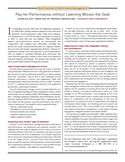
Pay-for-Performance without Learning Misses the Goal
For many employers and employees, the annual performance review is one of the most dreaded days of the year. All too often, managers aren't even sure how to assess employees when they are confronted with a blank performance evaluation form. Even employees who believe they are performing well will walk fearfully into the annual review because they aren't sure on what basis they are being assessed. Everyone involved in the performance management process has wondered the same thing at least once: Why bother?
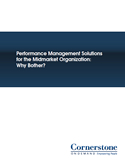
Performance Management Solutions for the Midmarket Organization: Why Bother?
In challenging economic times with ever-tightening competition for skilled labor, keeping employees happy has never been more important. Pay-for-performance (often called total compensation management) is a tool HR and talent professionals can wield in an effort to retain their best and brightest.

Social Networking in Talent Management
Corporate talent management is one of the most pressing issues in human resources and business today. The transformation of the global workforce and continuous business changes have created the need for an integrated approach to talent management – one which brings together the disciplines of workforce planning, sourcing and recruiting, performance management, leadership development, succession management, and compensation.

Strategic Employee Onboarding: First Impressions Are Everything
When companies hire a new employee, they often think of it as orientation. When the employee comes in on his or her first day, he or she is introduced to as many co-workers as possible, and then meets with someone from human resources to fill out forms and other necessary records so that the company has all the information it needs about its new worker.

Talent Management for Healthcare: Facilitating Organizational Excellence and Outstanding Patient Care
Healthcare providers today must wrestle with numerous talent challenges. For many, the challenges begin with compliance. Preparing employees for the scrutiny of a Joint Commission audit that could come at any time has transformed the approach to training and performance assessment.
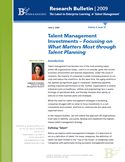
Talent Management Investments – Focusing on What Matters Most through Talent Planning
Talent management has become one of the most pressing topics within HR organizations today – and it is no wonder, given the current economic environment and business imperatives. Under the cloud of recession, the majority of companies is under increasing pressure to cut costs and reduce the workforce.
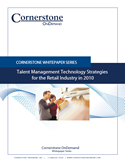
Talent Management Technology Strategies for the Retail Industry in 2010
As 2010 begins, the U.S. retail industry must prepare a talent strategy that is not geared entirely for recession or recovery, but something in between. A smaller talent pool, the workplace demands of Generation Y, education shortfalls and the decrease in interest in retail as career path will offer significant challenges for business leaders who are crafting talent strategies.

The Empowered Workforce: Crucial to Success in the New Economy
Organizations that have not only survived but thrived during the recession have focused with a laser-like intensity on the execution, productivity and performance of the business. But homing in on traditional business results has also escalated demands of the workforce. Staff cuts, tighter budgets and increasingly difficult workloads have created an environment in which employees are feeling overworked, undervalued and disengaged.

The Extended Enterprise: Using New Technologies to Extend Your Network, Enable Collaboration and Drive Revenue
Today, forward-thinking organizations are finding a fertile area for new growth in effectively reaching out to the extended enterprise of customers, partners and members to develop new profit centers, increase sales, cut support costs and boost channel productivity. In addition to traditional HR and learning circles, new users from sales, marketing, IT, customer service and other areas are now taking advantage of extended enterprise learning to engage, educate and certify customers and partners.
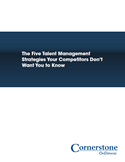
The Five Talent Management Strategies Your Competitors Don't Want You to Know
Employers need to develop talent management strategies to retain high-performing and high-potential employees, improve employee engagement, increase productivity and drive revenue.

The Leadership Revolution: Developing Talent in the New World of Business
In the new world of business, the identity of leadership is rapidly changing. Although traditional competencies such as integrity, vision, judgment and people development are still relevant, organizations needing to develop leaders must look beyond the conventional. They must create an environment that allows high performers to grow professionally and, ultimately, develop new skills that will lead businesses into the future.

The ROI of Talent in a Down Economy
There are 76 million baby boomers getting ready to retire. The beleaguered economy is putting unusual pressures on organizations, requiring them to do much more with a lot less. In the marketplace, there is a shortage of high performers. As a matter of fact, 70 percent of companies indicated that it is hard to find high performers – and almost as many companies say it is difficult to retain high performers once they are found. Further, companies are seeing a tremendous increase in turnover, due partly to the fact that Generation X and Generation Y employees are more inclined to change jobs and careers in order to fulfill their personal needs and goals.

Two Sides of the Same Coin: Using Succession Management and Career Development To Improve Talent Mobility
The paradox of today's economy is this: Even as unemployment rates linger near levels unseen in a generation, top talent is hard to come by. Anyone who is involved in a hiring function is already aware of this. And in a talent market where it is difficult to find top performers through external recruiting, more organizations are moving to develop internal talent programs to close the existing knowledge and skills gaps.
If you have any questions or to learn more, please contact us.

 We are extremely pleased to announce that Dresser & Associates has joined Net@Work, one of the most respected Sage Software Partners in North America and an award-winning end-to-end technology solutions provider. You will see very little change relative to your Sage Software support, really just a name change.
We are extremely pleased to announce that Dresser & Associates has joined Net@Work, one of the most respected Sage Software Partners in North America and an award-winning end-to-end technology solutions provider. You will see very little change relative to your Sage Software support, really just a name change.





